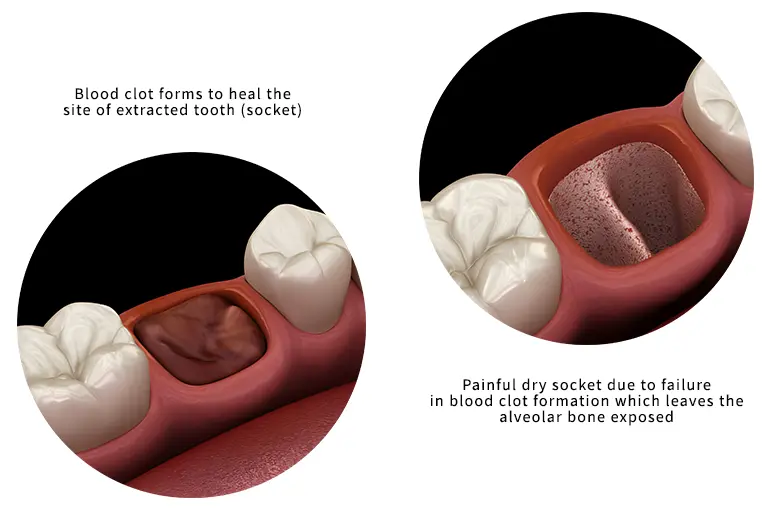If you have developed severe pain, bad breath, and delayed healing after a tooth extraction procedure, you will better call your dentist. You may have developed dry socket (alveolar osteitis), one of the complications of tooth extraction. Dry socket is not common and will affect mostly molar teeth extraction in the lower jaw.
Wisdom tooth extraction is the most possible procedure that a dry socket can show up. To rule out the possibility of other usual problems like bone spur, the dentist will examine the site of tooth extraction and may take x-rays to reach an exact diagnosis.
The pain of a dry socket can be severe and gives you discomfort. Therefore, you shouldn’t leave the painful socket to heal on its own since it can lead to more infection and other consequences. Seek a dentist’s help and follow care tips and treatment to manage the alveolar osteitis better with less feelings of pain.
What is dry socket?
Dry socket or alveolar osteitis is a common complication after a tooth extraction mostly from wisdom teeth extraction. Socket is referred to the place where the tooth is. Alveolar osteitis is a delayed healing problem. It happens due to incomplete or no blood clot formation of the socket in the extracted site.

If blood clot does not form on the socket of the extracted tooth area, the socket will be empty and the bone (jaw bone) will be exposed. This exposed alveolar bone is the cause of dry socket pain. You will feel throbbing pain and it can be a severe one.
Dry socket accounts for just about 2% to 5% of the total dental extraction and nearly 20% of all impacted tooth extraction procedures (wisdom tooth). Therefore, it is rare in usual tooth extraction, but mostly common in wisdom tooth extraction.
This complication mainly occurs in the extraction of the lower molar teeth. We can say that lower molars are the most affected teeth and you shouldn’t worry about every tooth extraction procedure.
Usually after 3 or 5 days after the extraction of the tooth, pain will start. The pain can be mild to severe, and you will experience a throbbing pain. The main source of your pain is the exposed bone and nerve on the socket.
A dry socket can take up to a week to heal, but the pain appears earlier on the third day of the extraction. The failure of the blood clot will cause discomfort as a result of severe pains in the site. You will need a dentist’s treatment to reduce the amount and occurrence of the pain during the healing time.
Signs and symptoms of a dry socket
You might ask yourself how I should know that I have a dry socket after my tooth extraction. The first thing is that the condition is rare and occurs mostly in molar teeth extraction in the lower jaw, especially in impacted teeth like wisdom tooth. If you have these signs and symptoms after your tooth extraction, you should see your dentist:
- An intense and throbbing tooth pain which can even cause earache and extend to your eye
- An empty socket with no sign of blood clot formation on
- Bad breath
- Bad mouth taste

Causes and risks of a dry socket
There are a number of causes and risks that increase the incidence of a dry socket, including:
- Lower molar teeth extraction
- The difficulty of tooth extraction as in wisdom teeth
- Trauma and injuries to the bone and soft tissues during the extraction procedure
- The existence of infection
- Past experience of alveolar osteitis
Other risk factors can be due to:
- poor oral hygiene and improper home care during the healing
- smoking and using tobacco products, which increases the risks of contamination and ultimately infection and delayed healing
- gum or tooth infection and high bacterial level due to preexisting dental and gum conditions
Prevention
Dentists can lower the occurrence of dry socket by several methods. They can use topical antibiotics like minocycline in the extraction site. A dentist will try to have a clean incision with the least possibility of infection and prevent any trauma or injuries to the bone and soft tissues. They will stop bacteria from getting into the socket and cause inflammation.
To decrease the alveolar osteitis risks after the surgery, dentist or oral surgeon will often use antibiotics such as tetracycline or minocycline on the socket and irrigate the wound by saline.
How do dentists treat a dry socket?
Treatment of the dry socket will reduce the pain and gives a relief during the time that the socket is healing. Immediately seek care and treatment after tooth extraction if the alveolar osteitis occurs.
Your dentist will apply a medicated dressing after the socket is cleaned of any debris and irrigated. The medicated dressing usually contains eugenol, butamben and a topical anesthetic. Dentists prepare an iodoform gauze that is soaked in the medicated dressing and put it on the socket.
Antibiotics and corticosteroids are also pain relievers for a dry socket, but due to side effects their use should be limited. For an immediate pain-killing effects, your dentist may prescribe low doses of corticosteroids with carbamide peroxide for around 4 days. Keep in mind your dentist will decide on the best treatment with the least side effects according to your needs and condition.
Home remedies for a dry socket
You can relieve your pain of alveolar osteitis if you follow what your dentist recommends. Your dentist can ask you to:
- Drink more water to keep the body and your mouth hydrated
- Take the pain medications as dentist recommends
- Avoid smoking
- Use salt water rinse to prevent any infection
- Eat soft and more liquid foods to prevent alveolar osteitis
- Brush or floss your teeth but gently and away from extraction site
